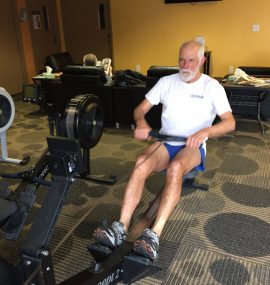Live longer and better
Maintain your independence, avoid disability
Older people who wish to live independently and maintain a high degree of autonomy over their lives need to keep moving. Recent research identifies two key aspects of keep moving that reduce risk of chronic diseases and disability until late in life: 1) aerobic fitness, and 2) muscle strength. Aerobic fitness refers to the ability of your circulatory system move oxygen to your brain, heart, and muscles. James Fries at Stanford University referred to using increased physical activity to avoid or delay the detrimental effects of chronic diseases as the compression of morbidity (illness). New research shows that tiny amounts (for example, 10 seconds) strong physical effort (for example, on a rowing machine or marching in place or walking fast up a steep slope) can improve aerobic fitness. With better aerobic fitness you’ll live with more energy, while you reduce your risk of cardiovascular disease and mental deterioration. Building skeletal muscle strength provides multiple benefits, including better cardiovascular health, along with lower risks of type 2 diabetes, frailty, and disability.
Some people who acknowledge that building muscle strength would improve their health and well-being but recoil at the prospect of going to the gym to work out. Is there a practical alternative to the gym to build muscle strength? Research shows that elastic resistance bands can build strength during single-joint exercises, such as arm curls. But do resistance bands work for exercises that involve multiple joints, such as lateral pulldowns or rowing or stiff-legged deadlifts or squats? Researchers in Norway addressed this question with a sample of 29 men and women young adults (average 25 years) who performed these four exercises with exercise machines then with elastic resistance bands. Sensors placed on the respective muscles to be trained measured muscle activation.
Traditional exercise machines produced significantly greater muscle activation, especially for stiff-legged deadlifts and squats, compared to the elastic resistance bands. Nevertheless, the resistance bands produced substantial activation of muscles involved in the lateral pulldown and the rowing exercises. Given that elastic exercise bands are relatively inexpensive, space-saving, portable, and versatile, the researchers concluded that bands offer a viable alternative to exercising at the gym. If you want to build muscle strength but don’t want to go to the gym, give exercise bands a try. Failure to maintain adequate aerobic fitness and skeletal muscle strength leads older people down the path to frailty and disability.
You probably think that greater muscle strength would help older people function better in the world. But would greater physical strength predict longer life? An international team of researchers conducted a systematic review and meta-analysis of 38 longitudinal studies with nearly 2 million participants to find out. The included studies primarily used hand grip strength as the measure of physical strength. It’s quick, non-invasive, and easy to measure in a doctor’s office. Some studies used leg extension ability as the strength measure. After accounting for confounding factors and compared to lower levels of hand grip strength, higher levels predicted a significant 31 percent decline in mortality risk over an average follow-up of 11.5 years. Women showed even greater mortality risk reduction (40 percent) than men (31 percent). Compared to lower levels of leg extension strength, higher levels predicted a significant 14 percent decline in mortality risk. Doctors could easily use low hand grip strength to identify patients at increased risk of premature death and refer them for strength training.
There’s a practical and validated way to test your own physical strength at home. The sitting-and-rising test (SRT) involves sitting down on a wood floor from a standing position then rising from the floor to a standing position. Scoring starts with a maximum of 10 points (5 for the sitting part and 5 for the rising part). One point is deducted for each use of support, such as placing a hand or knee on the floor, to sit or rise. Half points are deducted for poor form. Brazilian researchers asked if SRT scores for 2,002 individuals with an average of 63 years predicted their risk of dying prematurely. After adjusting for age, sex, and body-mass index and compared to participants with SRT scores of 8-10, participants with scores of 0-3 had a whopping 444 percent higher risk of dying over an average follow-up of 6.3 years. Middle-aged, physically infirm participants died sooner than participants who weren’t infirm. If dying prematurely and becoming disabled don’t appeal to you, find a training program that builds your aerobic fitness and physical strength.







